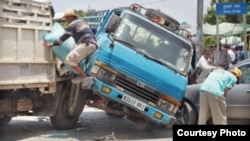Traffic accidents are the leading cause of death in Cambodia, destroying not only lives but also public spirit, dignity, property and national development efforts, a road safety expert told the Hello VOA call-in program on June 29.
In 2015, traffic accidents killed 2,265 people and injured more than 15,000 people, 40 percent of whom were seriously injured, said Ear Chariya, director of the Institute for Road Safety.
Although there was a 10 percent drop in deaths during the first six months of 2016 compared to the same period in 2015, traffic accidents remain the leading killer in Cambodia and one of the major challenges for national development, he added.
According to a 2013 study by Handicap International, traffic accidents cost the government $337 million that year, equal to about 3 percent of gross domestic product.
Chariya explained that this cost includes the destruction of vehicles and roads, administrative costs such as medical expenses and other related health-care expenses, court service fees, and non-productivity costs.
The dramatic costs of traffic accidents create a number of difficult consequences for families and society at large, he said.
The provision of medical treatments and other health-care services is a huge burden for the government, with some of the injured needing treatment of up to three months or over a year, while others become permanently disabled.
He added that some seriously injured victims need physical rehabilitation services which take time and are very costly.
The physical damage destroys victims’ mentality and spiritual strength, said Chariya, adding that it affects the mental health of both victims and family members who are indirect victims.
Traffic accident victims sometimes develop mental illnesses and suffer other psychological effects because of the losses of parts of the body and self-image.
Victims who develop serious mental health problem need counseling services which are currently inadequate and expensive in Cambodia.
Moreover, some children become orphans due to the deaths of their parents, and this circumstance shapes their future lives, he added.
Chariya claimed that traffic accidents significantly disrupt the Cambodian Millennium Development Goals, the first of which is to “eradicate extreme poverty and hunger.”
More than 80 percent of the dead are men between the age of 15 and 35 years old. Most of them are the bread winners in their households, the losses of which create financial instability for many victim families.
According to research conducted in 2010, traffic accidents cause a 21 percent reduction in the earnings for middle-income families.
For low-income families, the effect is even more severe. Chariya explained that some low-income families spend years trying to pay off debts they incur as a result of accidents. The destruction of the motorbikes in traffic accidents costs them dearly as they have often sold land and cattle to afford the vehicles. “They fall into poverty in a blink,” he said.
Traffic accidents also have a strong impact on education, he said. When the heads of the families die or become disabled, children often drop out of school to help ease the burden on the family. Research shows that the drop-out rate increases to 30 percent among the victims’ families.
“If our country has a number of drivers who do not respect traffic signs and lights, they [tourists] can judge at least on the surface that our country is full of law abusers,” he said.
“It also shows the government’s inability to enforce [traffic] laws, an ineffective judicial system and corruption.”









